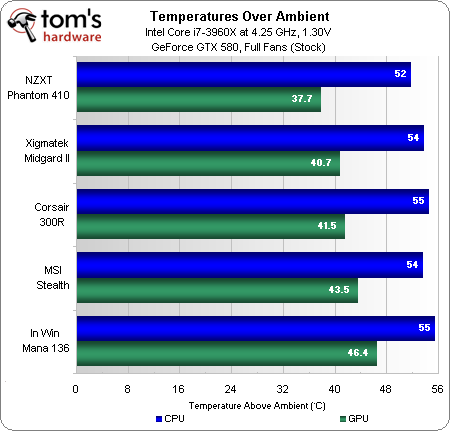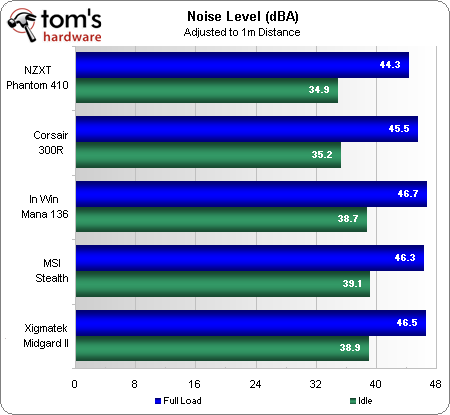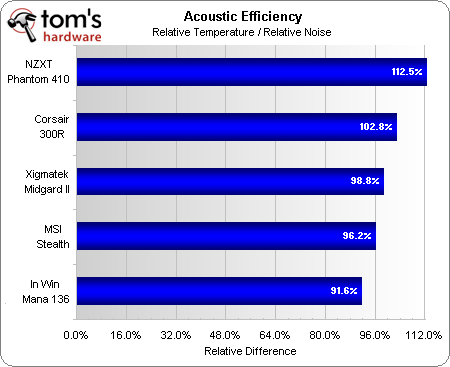Five Gaming Cases Between $80 And $120, Reviewed
Temperature, Noise, And Acoustic Efficiency
The two most closely-matched case designs take first and second place in our thermal tests, with the case that has the most factory-installed fans topping the chart.
While this editor finds drive doors inconvenient, they do occasionally help reduce the overall noise profile of a case. Thicker material also dampens noise, while vent size and location have a profound effect on how much noise escapes.
Similarities in internal design are not proven in noise dampening, as NZXT and Xigmatek take opposite ends of the chart. Corsair’s 300R is the quietest of the three thin cases, and it is also the coolest of those three.
For our cooling to noise comparison, the word relative refers to how each case compares to the average of cases in this review.
Because lower temperatures produce better results, an inverse scale of thermal performance is needed to give better-cooling cases a higher score. The average temperature of all cases is divided by the average temperature of an individual case to calculate its relative cooling.
The bottom number in a division problem is already inverted (a larger denominator produces a smaller fraction), so the average noise level of each case is divided by the average noise level of all cases to produce a direct result for relative noise reduction.
Taking first place in both cooling and noise, NZXT’s Phantom 410 has the most favorable cooling-to-noise ratio. Corsair continues its dominance as the best of the cheaper models, while Xigmatek’s poor noise control drops it to the middle of the pack.
Get Tom's Hardware's best news and in-depth reviews, straight to your inbox.
Current page: Temperature, Noise, And Acoustic Efficiency
Prev Page Test Settings And Benchmarks Next Page Which Chassis Delivers On Value? How About Quality?-
Ramlethal why is it between 80 to 120 if the most expensive ones are 410 and stealth priced at 100 ?Reply -
Crashman Reply
Because it was written four years ago?19046365 said:why is it between 80 to 120 if the most expensive ones are 410 and stealth priced at 100 ?
-
Tschrom Honestly, that's probably still true today, if not even cheaper. You can find good quality Full ATX cases for around $80 now, and to spend that much ($410) on a case is just a waste of money. If you really know what you're doing, you don't need to spend anywhere near that much on a case just to house your components. I'm using a Thermaltake Versa H22 SE, which is pretty small (only a mid-ATX case and cheap at only $40) in regards to cases, yet I am able to keep everything quite cool and even made some manual customizations to the case to ensure everything fits well and works well. And I'm using only Air Cooling. Really the case you use comes down to "do the components fit, and is there adequate cooling". Even then, the cooling part can be adjusted to what is necessary with some manual customizations or even just so much as ensuring that your case fans' CFM is adequate for cooling of your currently installed components (or water, but water cooling doesn't work in my current setup so I have no opinion on that).Reply



